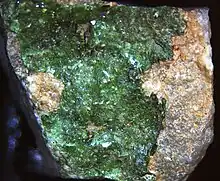Lindgrenite
Lindgrenite is an uncommon copper molybdate mineral with formula: Cu3(MoO4)2(OH)2. It occurs as tabular to platey monoclinic green to yellow green crystals.
| Lindgrenite | |
|---|---|
 Lindgrenite specimen from the San Samuel Mine of the Cachiyuyo de Llampos district, Copiapó Province, Atacama Region, Chile (field of view 4 mm) | |
| General | |
| Category | Molybdate mineral |
| Formula (repeating unit) | Cu3(MoO4)2(OH)2 |
| IMA symbol | Lgr[1] |
| Strunz classification | 7.GB.05 |
| Dana classification | 48.3.1.1 |
| Crystal system | Monoclinic |
| Crystal class | Prismatic (2/m) (same H-M symbol) |
| Space group | P21/n |
| Unit cell | a = 5.394, b = 14.023 c = 5.608 [Å]; β = 98.5°; Z = 2 |
| Identification | |
| Color | Green to yellowish green |
| Crystal habit | Tabular to platey crystals, may be acicular, massive or crust forming |
| Cleavage | Perfect on {010} and {101}, poor on {100} |
| Fracture | Micaceous |
| Tenacity | Brittle |
| Mohs scale hardness | 4.5 |
| Luster | Greasey |
| Streak | Pale green |
| Diaphaneity | Transparent |
| Specific gravity | 4.2 |
| Optical properties | Biaxial (-) |
| Refractive index | nα = 1.930 nβ = 2.002 nγ = 2.020 |
| Birefringence | δ = 0.090 |
| 2V angle | 71° (measured) |
| References | [2][3][4] |
Discovery and occurrence
It was first described in 1935 for an occurrence in the Chuquicamata Mine, Antofagasta, Chile, and named for Swedish–American economic geologist Waldemar Lindgren (1860–1939) of the Massachusetts Institute of Technology.[2][3]
Lindgrenite occurs in the oxidized portions of copper–molybdenum bearing sulfide ore deposits. Associated minerals include antlerite, molybdenite, powellite, brochantite, chrysocolla, iron oxides and quartz.[2]

Lindgrenite in a quartz vug from the type locality of Chuquicamata (size: 1.7 x 1.7 x 1.4 cm)

Lindgrenite, Inspiration mine, Arizona. Size 2 cm.
References
- Warr, L.N. (2021). "IMA–CNMNC approved mineral symbols". Mineralogical Magazine. 85 (3): 291–320. Bibcode:2021MinM...85..291W. doi:10.1180/mgm.2021.43. S2CID 235729616.
- Lindgrenite in the Handbook of Mineralogy
- Lindgrenite on Mindat.org
- Lindgrenite data on Webmineral
Further reading
- Calvert, L. D.; Barnes, W. H. (1957). "The structure of Lindgrenite". Can Mineral. 6 (1): 31–51.
- Xu, Jiasheng; Xue, Dongfeng (2007). "Hydrothermal synthesis of lindgrenite with a hollow and prickly sphere-like architecture". Journal of Solid State Chemistry. 180 (1): 119–126. Bibcode:2007JSSCh.180..119X. doi:10.1016/j.jssc.2006.09.030.
- Vilminot, Serge; André, Gilles; Richard-Plouet, Mireille; Bourée-Vigneron, Françoise; Kurmoo, Mohamedally (2006). "Magnetic Structure and Magnetic Properties of Synthetic Lindgrenite, Cu3(OH)2(MoO4)2". Inorganic Chemistry. 45 (26): 10938–46. doi:10.1021/ic061182m. PMID 17173452.
- Frost, Ray L.; Duong, Loc; Weier, Matt (2004). "Raman microscopy of the molybdate minerals koechlinite, iriginite and lindgrenite" (PDF). Neues Jahrbuch für Mineralogie - Abhandlungen. 180 (3): 245. doi:10.1127/0077-7757/2004/0180-0245.
- Kingsbury, Arthur W. G. (1955). "On the Occurrence of the Rare Copper Molybdate, Lindgrenite, at Brandy Gill, Carrock Fell, Cumberland". Mineralogical Magazine. 30 (230): 723–726. Bibcode:1955MinM...30..723K. doi:10.1180/minmag.1955.030.230.06.
- Bao, R; Kong, Z; Gu, M; Yue, B; Weng, L; He, H (2006). "Hydrothermal Synthesis and Thermal Stability of Natural Mineral Lindgrenite1". Chemical Research in Chinese Universities. 22 (6): 679. doi:10.1016/S1005-9040(06)60189-X.
- Barnes, W. H. "The unit cell and space group of lindgrenite" (PDF).
{{cite journal}}: Cite journal requires|journal=(help) - Miyazaki, Iyo; Ohori, Shinji; Kishi, Shigetomo; Kobayashi, Shoichi; Kusachi, Isao (2002). "Lindgrenite from the Sansei mine, Nara Prefecture, Japan". Journal of Mineralogical and Petrological Sciences. 97 (4): 207. Bibcode:2002JMPeS..97..207M. doi:10.2465/jmps.97.207.
Wikimedia Commons has media related to Lindgrenite.
This article is issued from Wikipedia. The text is licensed under Creative Commons - Attribution - Sharealike. Additional terms may apply for the media files.